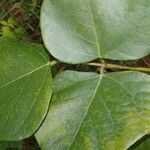Trees, branchlets smooth, lustrous, armed, the spines occasional, pyramidal, to 0.6 cm long, often obviously reflexed at the apex. Leaves with the leaflets 5-17 cm long, 5-20 cm wide, obliquely ovate to ovate rotund or the terminal leaflets subrhomboidal, as wide or wider than long, shortly acuminate apically, widely cuneate basally, the margins vaguely irregular, slightly revolute, thick charta-ceous, smaller leaflets often subcoriaceous, glabrous above, minutely puberulent beneath, often appearing glaucous, the main veins 5-6, petiolules to 1 cm long, glabrous, rugulose, often a different color than the rachis; petioles 4.5-15 cm long, glabrous; rachises 1.5-5 cm long, glabrous. Inflorescences to 0.5 m long, usually glabrous; pedicels to 10 mm long; bracts ovate, ca. 10 mm long; bracteoles narrowly ovate, acute, ca. 12 mm long. Flowers with calyx narrowly campanu-late, ca. 16 mm long and 4 mm wide, stiffly carnose, minutely puberulent, the teeth distinguishable as irregular and rounded elevations, standard elliptic, ca. 80 mm long and 20 mm wide, thick petaloid, glabrous, the wings oblong, ca. 10 mm long and 2.5 mm wide, tapering only gradually basally, the claw ca. 2 mm long; keel petals subcircular, ca. 8.5 mm long and 6.5 mm wide; odd stamen free at the base, then united to the middle of the sheath, the other stamens of 2 lengths, the laterally disposed stamens free for ca. 15 mm, the median (carinal position) free for 4-7 mm, the anthers ca. 3 mm long; ovary slender, stipitate for 1.5 mm, linear, ca. 17 mm long and 1.5 mm wide, ferrugineous puberulent, the style ca. 30 mm long, the stigma capitate, ca. 0.3 mm long. Legumes stipitate moniliform, to 15 cm long and 1.5 cm wide, the stipe 2.5 cm long.
More
A tree. It grows 6-10 m high. The crown is open. The leaves have 3 leaflets. These are 15 cm long and broadly diamond shaped. The flower clusters are erect and 15-30 cm long with bright red flowers along them. The fruit are woody twisted pods. These are 10-25 cm long and constricted between the seeds. There are many seeds and they are about 1 cm long. They are red with a black line.
Wet to dry thickets or thin forest, abundant in hedges and fencerows, usually at elevations below 1,000 metres, but also found up to 2,000 metres.
More
A tropical plant. In Central America it grows between 800-2,000 m altitude.


